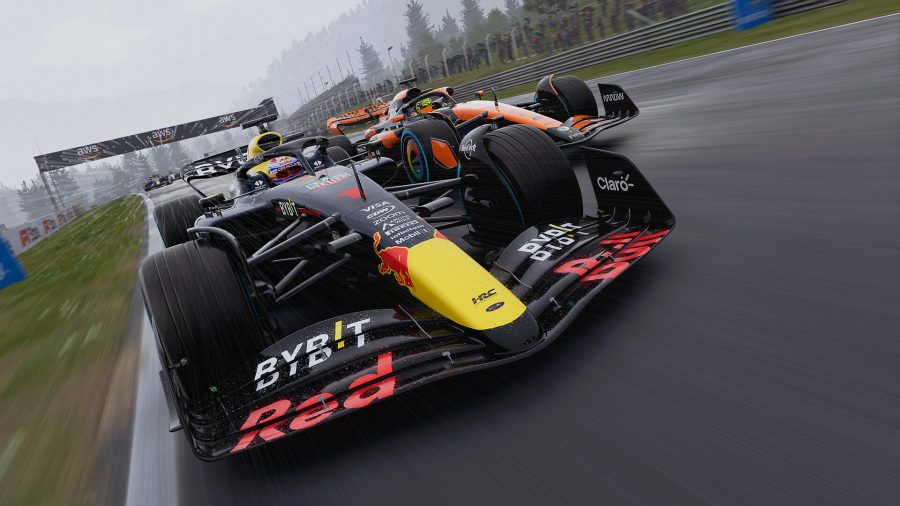Casey Ringley, a designer for EA Sports Codemasters and its forthcoming F1 24 racing simulation, understands why fans might be skeptical that the game’s renewed focus on vehicle physics and handling will actually make for a better driving experience. Formula 1 cars are notoriously challenging to drive in real life, and loading even more technical detail on top of the virtual cars doesn’t by itself guarantee a more fun video game.
But Ringley vows the changes coming to F1 24 do make the cars more understandable and easier to handle. “A lot of the systems that we’ve added are done with the intent of making the car more predictable,” he said. The upshot, novices and casual fans will find the game just as approachable as lifelong fans who drive with manual transmissions and have years of experience tuning their virtual cars.
For example, building a new suspension model allows the F1 24 cars to use what’s called “pro squat” suspension, which instead of making the car trickier to handle when taking a corner, applies more downforce and traction on the rear wheels, which should mean players of all ability will be able to take Monza’s tricky chicanes, or the roller-coaster banking at the Netherlands’ Zandvoort track, faster than before.
F1 24’s new vehicle physics make strategy more interesting
It’s not the sexiest back-of-the-box feature to tout, certainly not when you consider the series’ past three years of innovation, which delivered two chapters of a narrative mode as well as the deep and long-playing F1 World online suite. But it’s clear that, now two years into the racing series’ latest chassis design and vehicle regulations, Codemasters really wanted to build a game that took advantage of the reams of data they get from the racing teams, to give gamers cars that are truer to life than ever.
“It’s kind of a misconception that the more realistic you make things, they harder they have to be,” Ringley said. “That’s certainly possible, at the limit, but we’re still talking about cars with giant, very sticky tires. And the teams put a lot of work into designing these cars so that their drivers get an and feel confident to go out and push 110%, every lap. We aim to do that same kind of thing.”
That does mean getting into the weeds of vehicle performance, which means you’re going to have to take Ringley’s word for it, for now, that the cars drive in a different and better way that F1 fans will notice right out of the box. “You’ll notice the chassis responds more positively to your inputs as a driver, whether it’s feathering the brakes, to trail-brake into an apex, or feeling the suspension squat, and the tires bite into the track as the load shifts rearward under acceleration.”
This should — fingers crossed — make driving at F1’s so-called rear-limited tracks, for example Bahrain, a little more understandable, and perhaps even allow more drivers to take off assists, such as braking and traction control, without spinning out their rides. Last year’s F1 23 focused on making the game more accessible for gamepad drivers, with limited success. Traction control was still a necessity for a lot of gamepad players because of the touchy nature of a trigger-based throttle. The problem is, that assist makes the car slower. Codemasters isn’t guaranteeing everyone will start logging top 10 times at their favorite tracks, but the implication is there that F1 24 will unlock more of its cars’ natural quickness and agility.
There’s a knock-on effect to making the tires more realistic in F1 24, and that’s making tire strategy more of an active management challenge. “These changes combined with a new thermal model allow each player’s driving style to significantly influence tire performance and wear,” Ringley said. Notably, driving in wet conditions will have a noticeable cooling effect prolonging the tires’ life.
Setup options give drivers more power in critical moments
In previous versions of the racing game, tires behaved pretty much the same whether a driver was very aggressive with their speed and cornering on softer compounds or trying to get more life from harder ones to save time spent in the pits. This should also mean that watching your tire temperatures will be more meaningful, particularly in practice sessions as players try to find the best setup for the grand prix.
As far as setups, there’s a new engine-braking setting in the car tuning menus. What that means, Ringley said, is that players have more control over the harvesting and deployment of engine power under the hybrid era’s Energy Reduction System.
“This gives the player more freedom for a strategic energy harvest before making a pass, or saving up for an all out push late in the race to try to get the point for fastest lap,” Ringley said. And, by the way, the Drag Reduction System — the rear wing flap that can open under certain conditions to deliver even more speed to pressure and overtake another driver — will now be more distinctive to each car and less of a uniform speed boost.
The physics and handling upgrades will be applied to both the Formula 1 and Formula 2 cars serving the game’s deep career mode. This should also mean that player-developed cars in career, whether as a My Team owner-driver or the lead driver steering development for an existing team, will feel a lot more different and make decisions on what to upgrade, and when, a little more consequential.
F1 24 launches May 31 for PlayStation 4, PlayStation 5, Windows PC, Xbox One, and Xbox Series X.
Featured image via Codemasters.
The post F1 24 aims for more sophisticated physics — meaning faster and more fun cars appeared first on ReadWrite.




